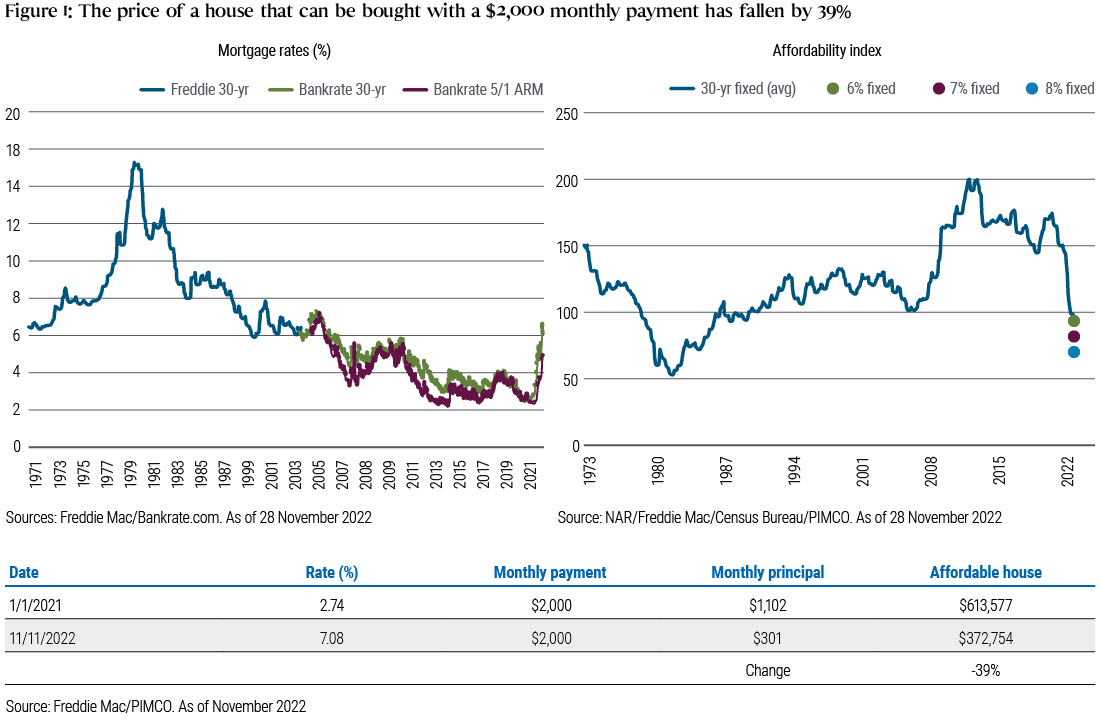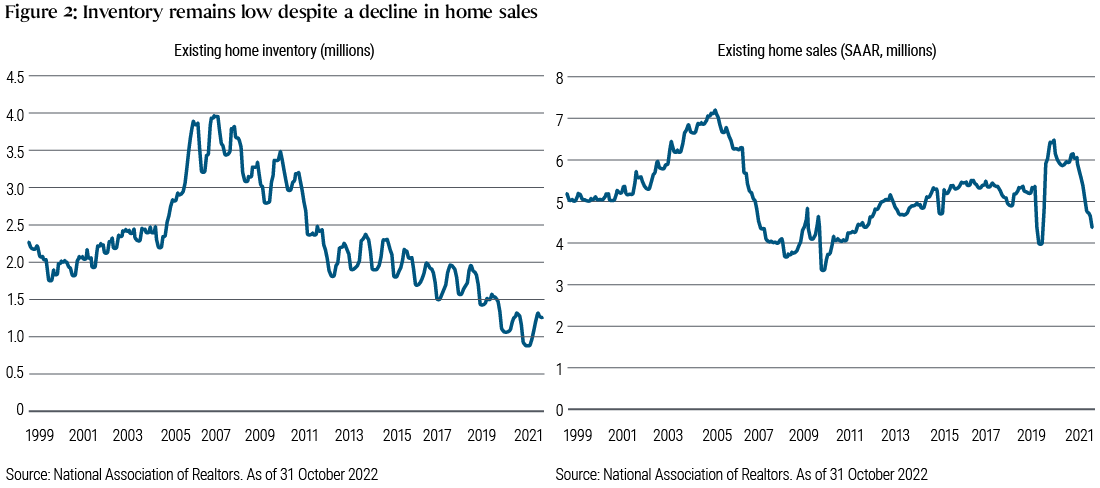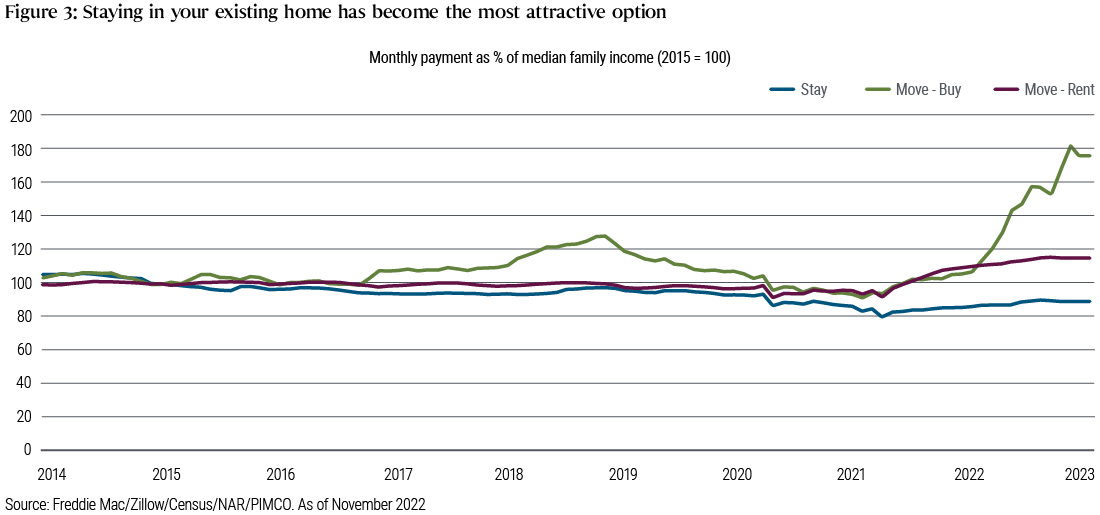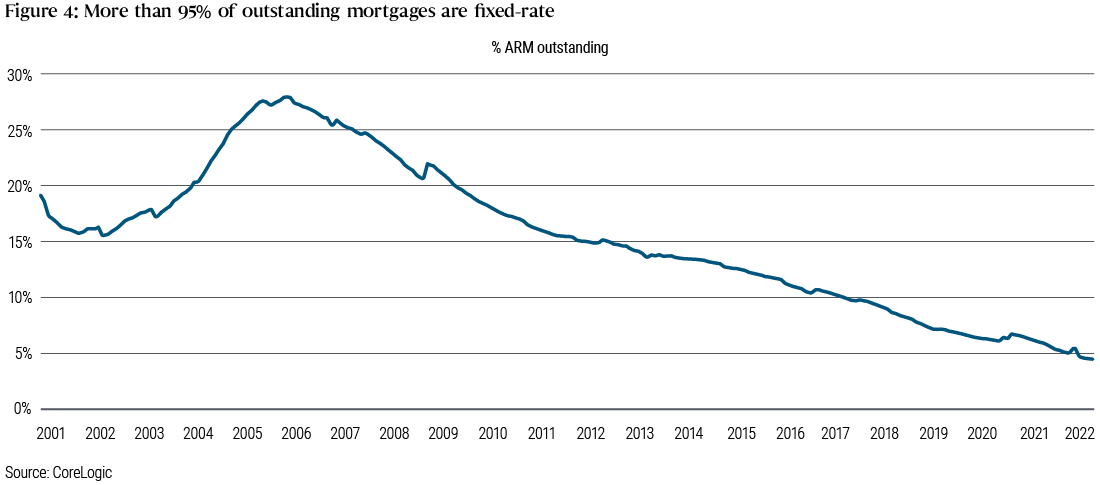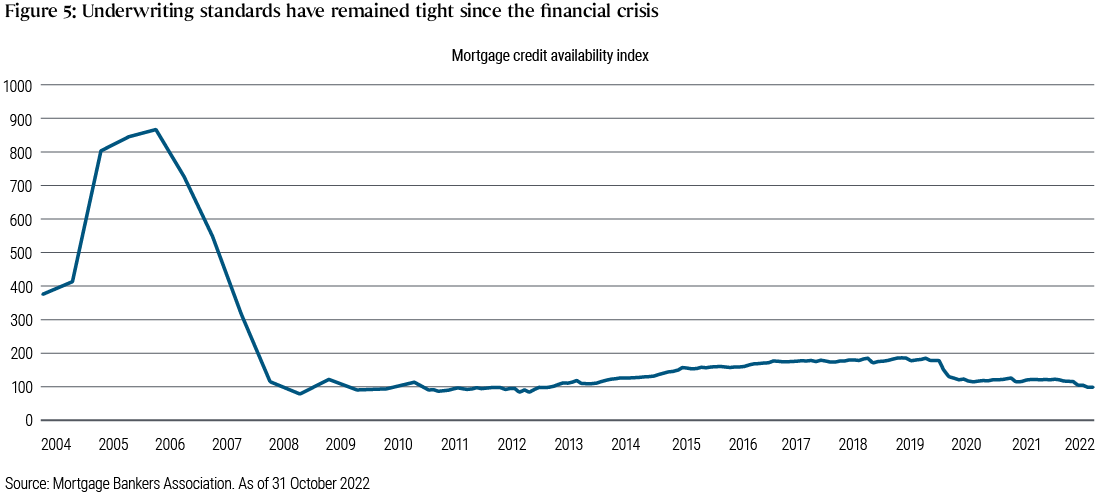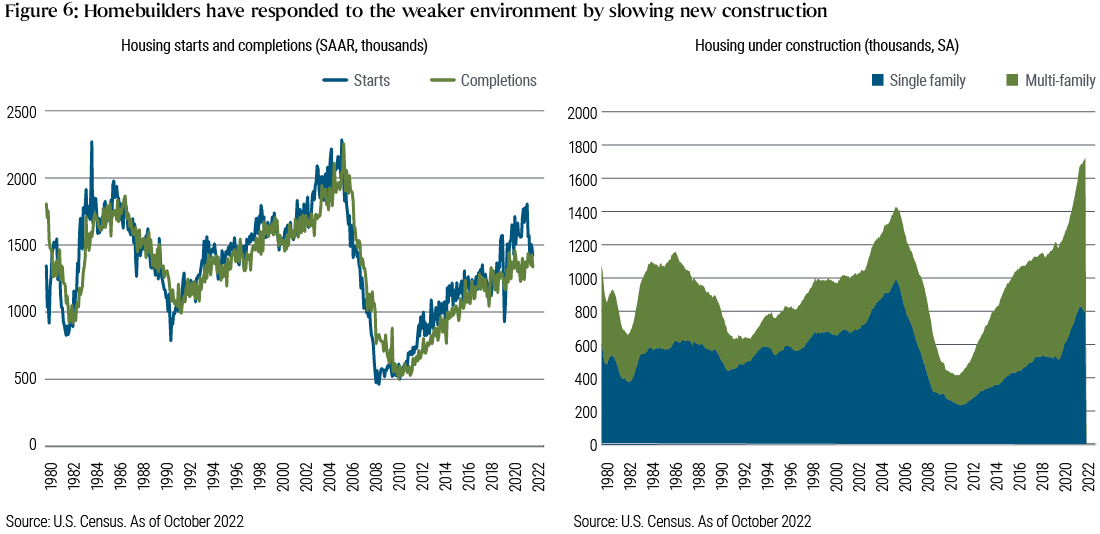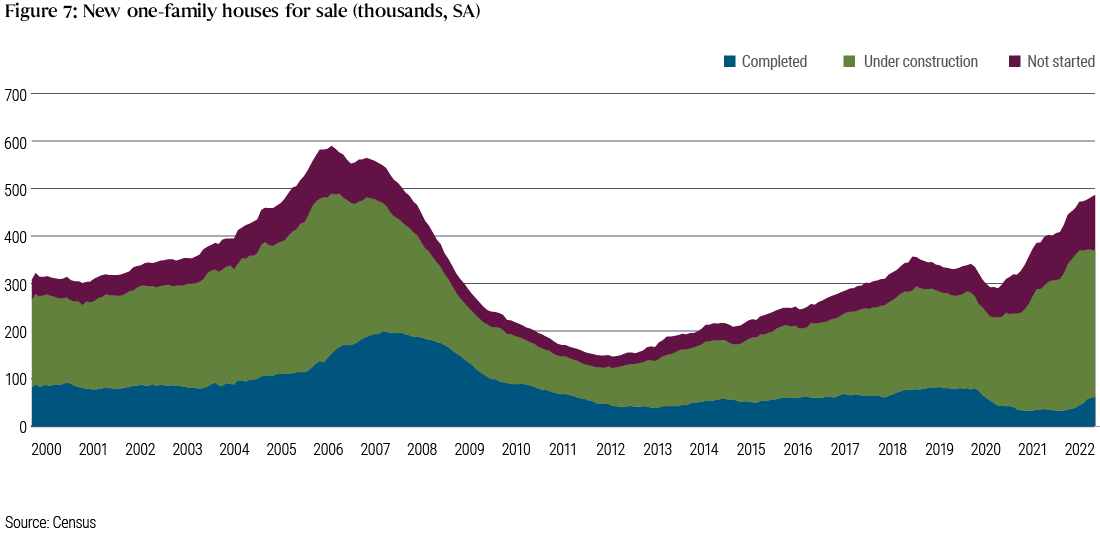Staying in Place ? The Post-Pandemic Housing Market
- U.S. home prices are likely to weaken further after the steep rise in mortgage rates in 2022, but tighter lending standards and lack of supply should make the decline less severe than in 2008.
- The current environment of diminished affordability and elevated rents strongly incentivizes homeowners to stay put, making it less likely that they will add to the supply of homes for sale.
- Long-run supply-and-demand factors remain favorable for housing, but watch new home inventories for any signs of mismatch between construction and demand.
- Assets exposed to the existing “stock” of established households will likely be insulated, while assets exposed to the “flow” of housing transactions appear more vulnerable.
Amid a decline in housing affordability, most U.S. homeowners will likely choose to ride out the sharp increase in mortgage rates and remain in their current homes. This stay-in-place dynamic is due to the current economic unattractiveness of moving to a different home, either by buying or renting, thus exacerbating the shortage of homes for sale and stifling market activity. While home prices should continue to weaken, we believe the low supply of houses for sale will ultimately provide support.
In terms of investment implications, we think it will be crucial to differentiate between assets that are exposed to the existing “stock” of established households (e.g., seasoned mortgages) and assets exposed to the “flow” of housing transactions (e.g., homebuilders, mortgage originators, and newly originated mortgages). We believe that the stock assets should continue to benefit, because homeowners have large positive home equity and historically low, locked-in mortgage rates. On the other hand, the flow assets will be directly exposed to the weaker environment.
All eyes on mortgage rates with affordability stretched
Since the beginning of 2020, home prices in the U.S. underwent an unprecedented appreciation of about 40%. While this run-up can at least be partially attributed to an increase in intrinsic demand due to pandemic-driven shifts in behavior, it was also accelerated by historically low mortgage rates, which reached a low of 2.6% at the end of 2020.
However, what was a tailwind in 2021 has reversed into a stiff headwind, with mortgage rates topping 7% in November before receding, causing monthly payments on 30-year fixed-rate mortgages to increase by almost 50% compared with the prior year. Even though nominal incomes have increased by 14% since the beginning of the pandemic, housing affordability – the ratio of family income to a typical mortgage payment on a newly purchased house – has deteriorated to its lowest point since the 1980s.
The speed and magnitude of the affordability shock have resulted in a drastic reduction in demand, with prospective buyers sitting on the sidelines to reassess their purchasing power. Housing market activity (as measured by existing home sales) started to plummet in the spring of 2022, and prices began to retrace pandemic gains shortly thereafter.
To be sure, some of the retracement is a reversal of extreme behavior earlier in 2022, when desperate buyers engaged in bidding wars that pushed homes well over listing prices. Nonetheless, given current affordability and the recent moves in rates, as well as the likelihood of a recession in the U.S., we expect further softness in real home prices in the coming quarters.
The chart below shows mortgage rates as well as affordability, which is gauged by the ratio of the median family income to the income necessary to buy the median house at an 80% loan-to-value (LTV) ratio and 25% debt-to-income ratio.
Activity is set to sink, but inventories will remain low as homeowners are locked in
Historically, inventory of homes for sale has been the most reliable predictor of future home price appreciation (HPA). From the all-time lows during the winter of 2021, and despite the rapid slowdown in sales, there are currently only 1.2 million homes for sale in the U.S., which corresponds to about three months of available supply. For context, a balanced market is typically considered to have six months of supply (2.2 million in the current environment)Footnote1. While every cycle is different, we should note that U.S. home prices have never fallen in a year preceded by housing inventory with less than six months of supply.
The situation also reminds us of the beginning of the 1980s, when housing activity plunged on a large increase in rates. While house prices dropped in real terms in the following years, HPA remained positive in nominal terms.
It may seem counterintuitive that inventories have increased so little given the decrease in demand, but that has simply been offset by a similar decrease in supply. As buyers retreated, would-be sellers, facing no obligation to sell, opted to sit out the weaker market, causing the number of homes listed to be 20% below the prior year’s level.
The current interest rate environment strongly incentivizes homeowners to stay put, as selling would generally bring increased housing costs such as higher mortgage payments (and higher property taxes in states such as California). Although the balance between choosing to rent versus buy has shifted toward renting, that is not an attractive option either, as rents have risen by 26% since 2019. Therefore, staying in place remains the cheapest option.
A decline in home prices is unlikely to snowball into more supply
In our view, a key difference between the housing market today and pre-2008 is the low likelihood of small (to moderate) price declines triggering large-scale selling that could spark a broader correction. At the start of the housing crisis in 2007, three different shocks accelerated the downturn:
- the number of borrowers in “affordability” products (option adjustable-rate mortgages or negative amortization loans) that faced payment shocks and were unable to refinance
- poorly underwritten borrowers who were acutely vulnerable to any economic downturn
- an oversupply of homes through new construction
On the first point, we anticipate a very limited number of borrowers will face payment shocks in the near future. Fortunately, negative amortization products have been consigned to the past, and about 95% of U.S. borrowers are in fixed-rate mortgages that insulate them from increases in rates (a key difference versus other countries like Canada, Australia, and the U.K.).
That said, corporate and institutional real estate investors that own single-family rental (SFR) properties are vulnerable to refinancing risk. But we do not think these borrowers present a systemic risk, as they represent a relatively small slice of the overall market and their holdings are concentrated in specific, urban geographies.
The second source of potential supply – distressed borrowers – should also be limited. Due to more stringent standards and credit underwriting after the 2008 global financial crisis (GFC), borrowers are in a much better financial position to weather increases in unemployment and other economic stress. In instances where the post-crisis origination regime has been tested (e.g., COVID-19, hurricanes, etc.), loan performance has typically held up well.
Relatedly, the average household balance sheet remains healthy, and borrowers have little incentive to default after locking in low mortgage payments and building up significant home equity. Further, existing homeowners have seen declines in mortgage payments in real terms given sizable nominal wage increases over the past two years.
So while affordability for prospective buyers has become more challenged, the position of existing homeowners generally remains fairly strong. To the extent that some borrowers do fall behind on monthly payments, loan servicers have, in the wake of the GFC, developed a range of modification tools that can soften the blow and hopefully forestall borrower defaults.
The secular shortage of housing remains, but watch new home inventories for signs of mismatch between construction and demand
The picture for new construction is more mixed. While there remains a secular shortage of single-family housing due to 10 years of under-constructionFootnote2 there was significant construction during the pandemic that was probably enough to keep pace with the natural rate of household formation (but insufficient to chip away at the long-term deficit).
Currently, there are about 1.7 million housing units under construction (800,000 single-family homes), but a large percentage is either already sold or not for sale. In addition, as evidenced by the gap between housing starts and completions, supply-chain bottlenecks disrupted construction and builders had difficulties finishing homes, which artificially increased the total number under construction.
There is a risk that some of this new supply does not match the new economic reality of affordability-constrained demand, as could be indicated by the recent increase in the inventory of new homes for sale. However, if all the homes under construction were to simply be placed on the market, this would be equivalent to 1-2 months of additional supply, not enough to take us to the historically balanced level of six months. Furthermore, homebuilders have already increased discipline by focusing on existing construction without embarking on new groundbreakings, as demonstrated by the recent decrease in construction starts.
Home prices will continue to lag, but we believe that the correction should be moderate because of chronic undersupply
In summary, we expect a continuation of the current stay-in-place market dynamic, with low activity as both buyers and sellers wait for less uncertainty and better economics. Inventories should remain low, and the discrepancy between what buyers can afford and what sellers are willing to accept will remain large. The few sellers willing to put their homes on the market and accept an offer will be the very motivated ones, which could result in an overall decrease in prices. However, we think that the supply side is more fundamentally stable than pre-GFC, as many homeowners have the financial means and incentive to stay off the market.
Under these conditions, the decrease in home prices should not turn into a spiral, and we expect the total price correction to be moderate. Beyond the next few quarters, we expect a gradual normalization of affordability through an increase in nominal incomes and lower mortgage costs from a normalization of mortgage spreads, as illustrated in the table below.
In a scenario where incomes increase by 5% and mortgage rates normalize to 5.5%, a decrease in house prices of 5% to 10% would normalize affordability back to levels seen in the 1990s-2000s. To be sure, this scenario could change in the event of a more severe recession than is currently anticipated or a significantly higher-than-expected move in rates.
Investment implications
Given our expectation of a controlled landing in house prices, “stock” assets such as seasoned residential mortgage-backed securities continue to look particularly attractive at current levels. We believe that overall rates of default should remain low, given borrowers have built considerable property equity and have healthy balance sheets, while recovery rates on defaults should be supported by the past gains in home prices. Moreover, while current affordability is stretched, existing monthly payments have decreased in real terms for many homeowners, given the rise in household incomes over the past two years.
On the other hand, “flow” assets that depend on either continued strength in housing sales volume or continued home price appreciation should suffer in a declining market. We are also particularly vigilant with regard to bonds linked to 2021 and early 2022 originations, as some of these pools may have borrowers in specific West Coast markets, such as parts of the Pacific Northwest, that are already underwater. It is also possible that some of the borrowers in these vintages may not be as financially strong as their credit scores would suggest due to pandemic-led stimulus and debt-payment holidays.
For more on our investment views, please see our latest Asset Allocation Outlook, “Risk-Off, Yield-On”.
1 For comparison, there were over 4 million homes for sale on the eve of the global financial crisis in 2008. Return to content
2 Estimates of the secular shortage of single family housing vary from 2 million to 6 million, depending on the source and the methodology. Return to content
Featured Participants
Disclosures
Mortgage- and asset-backed securities may be sensitive to changes in interest rates, subject to early repayment risk, and while generally supported by a government, government-agency or private guarantor, there is no assurance that the guarantor will meet its obligations. References to Agency and non-agency mortgage-backed securities refer to mortgages issued in the United States.
PIMCO as a general matter provides services to qualified institutions, financial intermediaries and institutional investors. Individual investors should contact their own financial professional to determine the most appropriate investment options for their financial situation. This material contains the opinions of the manager and such opinions are subject to change without notice. This material has been distributed for informational purposes only and should not be considered as investment advice or a recommendation of any particular security, strategy or investment product. Information contained herein has been obtained from sources believed to be reliable, but not guaranteed. No part of this material may be reproduced in any form, or referred to in any other publication, without express written permission. PIMCO is a trademark of Allianz Asset Management of America L.P. in the United States and throughout the world. ©2023, PIMCO.
CMR2022-1123-2609436

